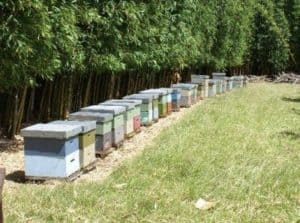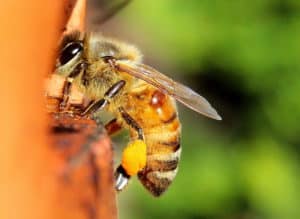Bees have incredible navigation abilities that allow them to fly miles away from the colony to forage and return home with enough precision to locate the entrance to their colony, even when there are dozens of nearly identical hives within a small apiary site. The current understanding of navigation is that a combination of position relative to the sun and landmarks across the landscape get them close and then a combination of visual cues and pheromones to precisely locate the colony entrance. When a returning forager ends up returning to the wrong colony, she is typically not attacked as a robbing bee but accepted into the colony due to the pollen or nectar she carries. This process, known as drift, can lead to significant variations in colony strength over time and increase the potential for the spread of diseases and parasites within an apiary. Drift is generally not viewed as a huge problem, but there are some steps beekeepers can take to mitigate the amount of drift happening in their apiaries.

When colonies are aggregated in large numbers and placed in rows of pallets, as is common in a commercial setting, there is potential for excessive drift. Many beekeepers elect to paint all of their woodware white, and this decision may be based on tradition, aesthetic, or other considerations. Others use a variety of colors, which creates a more vibrant apiary and may also help returning forages with orientation. While bees do not see the same spectrum of colors as humans, they are able to distinguish between different shades, assisting them in orientation. In general dark colors should be avoided, particularly in excessively warm and sunny locations, so colonies will not become excessively hot. However, a mix of pastel colors and tones can provide some variation to help bees distinguish individual colonies without adding the potential for thermal stress.


In addition to variations in color, placement relative to other colonies and objects in the landscape can offer navigational aids that limit drift. Many beekeepers have observed that when a number of colonies are placed in a long line the colonies at the downwind end of the line accumulate more bees and yield greater honey harvests while those at the upwind end of the line are often short on bees and lighter in honey stores. By placing an array of hives in circles or arcs, with entrances pointed in different directions, the downwind drift effect can be lessened. Prominent landscape features can also be helpful in providing orientation assistance. In addition to potentially providing a windbreak, a structure, tree line, or hedgerow close to hives can reduce drift. Orientation landmarks can be particularly important when setting up yards for mating nucs. It is essential that queens return to the correct nuc after orientation and mating flights so extra consideration should be given to visual cues in order to minimize drift in mating yards.

Drift is not something that most beekeepers give a lot of thought and it is certainly not among the most critical factors impacting colony health. Nevertheless, there is a growing understanding of the impacts of horizontal transmission of varroa mites between colonies and the ability to control varroa levels within and between apiaries. Phoretic varroa on drifting foragers are one way that ‘clean’ colonies may become reinfested. Given the ever-increasing number of challenges to bee management, reducing drift represents one area where beekeepers can potentially reduce colony stress for a minimal amount of effort.